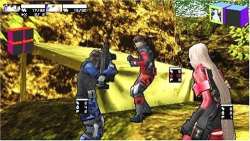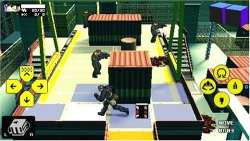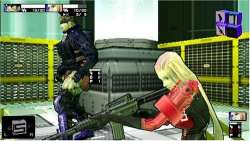Metal
Gear Acid 2 for the PSP offers more tactical card-based play, but the interface
is more intuitive. This improves the gameís overall feel with easier movement
while speeding up the pace. For those used to the console games, MGA2ís
tactical approach seems odd initially, but its depth and engaging storyline
gradually wins you over. MGA2ís enhancements include cel-shaded visuals,
online battles, increased card selection, more varied moves and the ability to
face off against boss characters in arenas. In addition, thereís a new Solid
Eye feature which allows players to view the action in 3D. This is more than a
gimmick however, so read our review and find out why this is an enjoyable sequel
that expands on the original while retaining the originalís unique play
mechanics.
 Transforming
Metal Gear Solid into a tactical card game probably seemed counter-intuitive at
the time, but last yearís initial Metal Gear Acid title showed that these
genres could blend together successfully. Now Konami is back at it again, with a
refined installment that smoothens some of the rough edges and control issues to
create a much more cohesive title that faithfully adapts the series into a new
form while improving on its presentation and gameplay mechanics. Metal Gear Acid
2ís levels and structure are simpler this time around. Before each mission
begins, you are given an objective that needs to be completed. These objectives
are usually indicated by blue circles on a square, which you need to guide Snake
towards. However, this isnít as easy as it sounds, since there can be
obstacles in your path. In order to help Snake along in his mission, players can
use the camera to zoom in and out or change the angle of the camera. Changing
the viewpoint also helps you with movement, since the controls are mapped to the
direction of the camera. Unlike the oblique controls in the first Acid, the
in-game menus are simpler in approach this time around, with brighter icons that
make it much easier to see what actions to push to perform specific actions. In
addition, the game now includes a short series of training levels which help you
get the basics down, which makes things understandable in a relatively short
time.
Transforming
Metal Gear Solid into a tactical card game probably seemed counter-intuitive at
the time, but last yearís initial Metal Gear Acid title showed that these
genres could blend together successfully. Now Konami is back at it again, with a
refined installment that smoothens some of the rough edges and control issues to
create a much more cohesive title that faithfully adapts the series into a new
form while improving on its presentation and gameplay mechanics. Metal Gear Acid
2ís levels and structure are simpler this time around. Before each mission
begins, you are given an objective that needs to be completed. These objectives
are usually indicated by blue circles on a square, which you need to guide Snake
towards. However, this isnít as easy as it sounds, since there can be
obstacles in your path. In order to help Snake along in his mission, players can
use the camera to zoom in and out or change the angle of the camera. Changing
the viewpoint also helps you with movement, since the controls are mapped to the
direction of the camera. Unlike the oblique controls in the first Acid, the
in-game menus are simpler in approach this time around, with brighter icons that
make it much easier to see what actions to push to perform specific actions. In
addition, the game now includes a short series of training levels which help you
get the basics down, which makes things understandable in a relatively short
time.
As
in the first Acid, the game revolves around an elaborate system of cards and
decks, where the decisions and movements a player makes depend on which cards
they draw. There are two kinds of cards that either control your characterís
movement and equipment. Most
cards in the decks can be used for either type of action. When you select a
card, you decide whether to implement its feature, such as using a gun or a
technique that is effective immediately. Several cards can be equipped, usually
a defensive move such as evade or hiding under a box that occurs in the next
round of play. If a player wants to move snake around the level, a series of
yellow blocks show up which show where he can move. Players can change Snakeís
direction, or make him crawl through tunnels. When he is crouching or crawling,
his movements are much more limited. Each playerís turn consists of two basic
draws from the deck, at which point the enemy forces can move around for two
turns as well. Players can increase their number of moves per turn by using
special cards and can decrease the amount of time each move requires. There are
additional cards that the player can select to set traps and other obstacles
such as stun grenades at foes.
 As
you progress through each level, your selection of cards will slowly diminish,
but you have the option of discarding unwanted cards, and can plan on a deck
reset every couple of turns to replenish your arsenal. Unlike the first game,
which offered a somewhat limited selection of cards, Acid 2 offers a greater
variety, and the ability to purchase additional decks later on, which increases
the variety and effectiveness of your attacks. Players can also manage their
decks and cards in a newly expanded menu that includes extensive background and
instructions on each cardís uses and mechanics. This deeper system is actually
easy to navigate, giving the card system a more straightforward structure that
makes playing the game much simpler.
You can only access these menus between levels, which can be annoying,
though it seems to make sense. After youíve managed your cards and set up your
decks, you can go back to the main mission. As always, the key to the game is
evading detection, though things arenít as unbalanced if you are spotted,
meaning death isnít a predetermined outcome. The gameís combat system
isnít as convoluted this time around, and makes it much easier to attack foes.
Using the weapons cards is simple, just select a nearby opponent and the weapon
fires automatically at opponents. With standard guards, your shots generally hit
the first time, which makes the early levels relatively easy to beat. Later
enemies require special weapons and attacks, which adds another level of
strategy to the game. Players can also call on special boss character cards
during battles that unleash a powerful wave of attacks that generally kill any
one in their path instantly. Another key aspect of the game is knowing when to
use attack cards and saving those powerful cards for situations where they are
really needed. Making
these decisions harder is the fact that you never know which cards will come up
in the next draw, and its this random aspect that makes the game more
interesting.
As
you progress through each level, your selection of cards will slowly diminish,
but you have the option of discarding unwanted cards, and can plan on a deck
reset every couple of turns to replenish your arsenal. Unlike the first game,
which offered a somewhat limited selection of cards, Acid 2 offers a greater
variety, and the ability to purchase additional decks later on, which increases
the variety and effectiveness of your attacks. Players can also manage their
decks and cards in a newly expanded menu that includes extensive background and
instructions on each cardís uses and mechanics. This deeper system is actually
easy to navigate, giving the card system a more straightforward structure that
makes playing the game much simpler.
You can only access these menus between levels, which can be annoying,
though it seems to make sense. After youíve managed your cards and set up your
decks, you can go back to the main mission. As always, the key to the game is
evading detection, though things arenít as unbalanced if you are spotted,
meaning death isnít a predetermined outcome. The gameís combat system
isnít as convoluted this time around, and makes it much easier to attack foes.
Using the weapons cards is simple, just select a nearby opponent and the weapon
fires automatically at opponents. With standard guards, your shots generally hit
the first time, which makes the early levels relatively easy to beat. Later
enemies require special weapons and attacks, which adds another level of
strategy to the game. Players can also call on special boss character cards
during battles that unleash a powerful wave of attacks that generally kill any
one in their path instantly. Another key aspect of the game is knowing when to
use attack cards and saving those powerful cards for situations where they are
really needed. Making
these decisions harder is the fact that you never know which cards will come up
in the next draw, and its this random aspect that makes the game more
interesting.
For
a turn-based strategy game, Metal Gear Acid 2ís main gameplay is surprisingly
exciting and offers players the chance to play an involving mission with a great
storyline. The gameís presentation and visuals have been upgraded and changed.
The levels have been designed with a new cel-shaded approach that gives the game
a bright neon-yellow look. Adding the gameís visual punch are the character
and model designs, which seem slightly less realistic this time around, with
more exaggerated character models. One interesting aspect of Acid 2 involves the
use of a unique 3D graphics gimmick called Solid Eye. This is an option during
the main game, but required to view any cinema extras you unlock during the
missions. This requires you to put on the included 3D glasses that attach on the
PSP to view the action. While the effects create a convincing
sense of depth, using the glasses is optional, the glasses arenít necessary to
play. The gameís levels retain a classic Metal Gear style with plenty of
industrial and military style areas to explore. As in the last MGA title, most
of the dialogue occurs in pop up menu displays with very little voice acting.
This gives the game a slightly disconnected feel, as does the mostly top-down
viewpoint thatís used throughout. There are some cinematic sequences where the
action zooms in, but for the most part, the game keeps you at a slight distance
from the action. The advantage of this is that it allows you to concentrate on
the strategic card based play, though it does tend to keep you from fully
getting into the gameís storyline. Acid 2ís plot isnít as cohesive as the
first gameís, and the odd quirks and strange detours this time around make
this a more surreal experience. Adding to this are occasionally bizarre
cut-scenes and cinemas you can unlock in the Solid Eye mode, which range from
cut-scenes from previous MGS titles to weird sequences involving a model holding
guns provocatively. This is strange, but the gameís overall comic book visuals
are colorful and interesting nonetheless, and show off the PSP system while
helping to separate Acid from the main storyline.
 In addition to the
solidly entertaining single player experience, MGA2 also includes several cool
online modes of play that lets players battle it out online using the PSPís
wi-fi connection. In addition, players who own Metal Gear Solid 3: Subsistence
on the PS3 can connect the game together to unlock additional content. Overall,
this is a solidly entertaining game that improves on the tactical combat of the
first title thanks largely to it streamlined, simplified interface. Controlling
Snakeís actions and movements is much easier now thanks to the onscreen icons,
which make playing through the levels much easier. Adding to the enjoyment, Its
visual presentation has been given an appealing cel-shaded overhaul that
brightens the action considerably. The comic-book styled presentation also ties
in nicely to the slightly more exaggerated plot, increasing the gameís overall
entertainment value. While it seemed like an odd blending of genres the last
time around, Metal Gear Acid 2 successfully builds on the promising elements of
the first game, delivering a faster-paced and generally more entertaining
experience this time around. Itsí mix of tactical combat with traditional
stealth action is appealing and should satisfy gamers looking for a more
experimental take on the series.
In addition to the
solidly entertaining single player experience, MGA2 also includes several cool
online modes of play that lets players battle it out online using the PSPís
wi-fi connection. In addition, players who own Metal Gear Solid 3: Subsistence
on the PS3 can connect the game together to unlock additional content. Overall,
this is a solidly entertaining game that improves on the tactical combat of the
first title thanks largely to it streamlined, simplified interface. Controlling
Snakeís actions and movements is much easier now thanks to the onscreen icons,
which make playing through the levels much easier. Adding to the enjoyment, Its
visual presentation has been given an appealing cel-shaded overhaul that
brightens the action considerably. The comic-book styled presentation also ties
in nicely to the slightly more exaggerated plot, increasing the gameís overall
entertainment value. While it seemed like an odd blending of genres the last
time around, Metal Gear Acid 2 successfully builds on the promising elements of
the first game, delivering a faster-paced and generally more entertaining
experience this time around. Itsí mix of tactical combat with traditional
stealth action is appealing and should satisfy gamers looking for a more
experimental take on the series.
